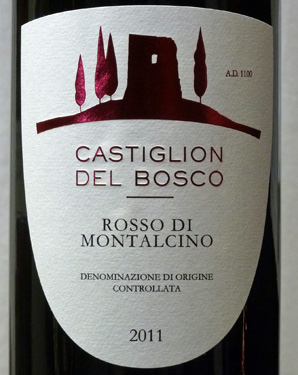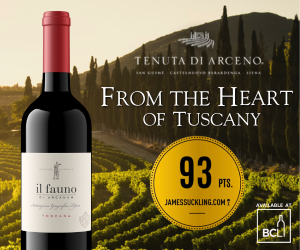The mention of red fruits versus black fruits may be the most favourable descriptor one can use to describe red wine at the moment, at least among wine reviewers and professional critics.

The mention of red fruits versus black fruits may be the
most favourable descriptor one can use to describe red wine at the moment, at
least among wine reviewers and professional critics. After decades of chasing
intensity and concentration of fruit, along with a commensurate level of oak
and alcohol, the style of red wine is fundamentally changing in many regions of
the world.
There are many reasons for the shift to fresher,
brighter, leaner reds, none more important than they are better matched to
food. But even before we get it to the table, it's clear to many winemakers
that if you are going to tie your hat to terroir and region the wine has to be,
figuratively and literally, more transparent to allow the site or vineyard
where the grapes are grown to shine through in the bottle.
It wasn't all that long ago Pinot Noir, Cabernet
Sauvignon and Zinfandel was routinely bottled at 15 to 16 or even 17 per cent
alcohol, and it was all bathed in new, heavily toasted French or American oak
barrels. Much like the New World Chardonnay of the 1980s and '90s, all you
could taste was the flavour of oak and all you could feel was the weight of the
alcohol.
Those days are fading fast. In the last week I tasted
some terrific wines from Argentina, Italy and Australia that perfectly
illustrate the notion that balance and finesse, and more red fruit than black
is a good thing in wine.
It may sound odd given the morass of no-name sweet reds
that are creeping into wine shops to satisfy a sector of the wine producers
pandering to entry-level wine drinkers using residual sugar, but I'm hopeful
the days of alcohol, oak and sugar are coming to a quick end. I believe you
cannot make wines that come from somewhere unless they have a story to tell,
and it's the lighter, more pure fruit style of wines that are the storytellers.
Argentine winemaker Sebastian Zuccardi was in town twice
last month to discuss his latest wines coming from Argentina's Mendoza Valley,
all fermented in neutral cement fermenters. Zuccardi is seeking out the purest
expression of Malbec where fruit and acidity meet to tantalize your tastebuds.
Where every sip suggests another. Sangiovese has always been a floralscented,
red fruit grape, but over time, many Tuscan producers lost their focus trying
to make bigger, richer style blends with the addition of Cabernet Sauvignon,
Merlot and even Syrah to try to match the big reds of the day coming out of
California and Australia. At an Altesino tasting last week, the highly
respected Brunello di Montalcino producer is focused on refinement, choosing
sites and blends that celebrate the ethereal red fruits of Sangiovese and then
aging them in older wood, eschewing power and weight for finesse and grace.
Even more striking was recent tasting with winemaker Sue
Hodder, who has been quietly reshaping the Cabernet Sauvignons of Wynns
Coonawarra over the last 22 years along with viticulturalist Allan Jenkins.
When Hodder arrived at Wynns, John Riddoch was a Cabernet Sauvignon that was
bathed in oak and expected to age perfectly over the next 20 years.
It may have worked in the greatest vintages when
everything was in balance, but those harvests are few and far between in cooler
regions. The trick today is to coax that character out of every harvest. In
Coonawarra, Wynns has completely renovated its vineyards. The goal is to bring
those grapes to perfect ripeness in almost every vintage and to harvest red
fruits over black, finesse over power, leading to drinkability over all other
attributes. It's the New World of red wine, and it can't come fast enough for
this critic.
Tranchero Casot
Moscato d'Asti 2012, Piedmont, Italy
Price: $20 | Score: 89/100
UPC: 00335096910378
Consistent here with its frizzante style and big rose
petal, nectarine, spicy, honey, baked pear and lychee aromas. Fresh, crisp,
juicy, frizzante palate with medium sweetness. Lots of nectarine, rose petal,
spicy, honey, ginger and green apple flavours. A sweeter style but very good
fruit and intensity with nice acidity. Fun for all, especially at 5.5 per cent
alcohol. Party on
Porcupine Ridge
Syrah 2012, Coastal Region, South Africa
Price: $17 | Score: 87/100
UPC: 746925000786
One of the better SA Syrahs we see here in Canada. It has
a mix of spice, smoke and chocolate cherry fruit with meaty, peppery, coffee
aromas. The palate is similar with rich peppery cherry/berry jam flavours with
a fair bit of oak and a touch of scorched earth and tar among its dry finish.
Barbecue flank steak is the match.
Ghost Pines Red
Blend 2011, Sonoma Valley, Sonoma County, California, United States
Price: $25 | Score: 87/100
UPC: 850000204535
Finally a wine with some fruit and flavour but without
too much sweetness. Love that savoury Sonoma cassis and menthol with soft
vanilla-laced tannins in the back end. Fine density and texture if a bit short
overall in the finish. A solid finish in what is a fair value red.
Pasion de Bobal
2010, Utiel-Requena, Valencia and Murcia, Spain
Price: $19 | Score: 89/100
UPC: 8436017631319
Bobal is the third most-planted variety in Spain but it
is hardly a household name. In Utiel-Requena a region where it reigns supreme,
it seems to over deliver for the price. Grown on a hot site at almost 1000
metres it has the gloss and fruit you would expect, a dash of oak and a slim
finish with enough acidity to get your nose back into the glass. Produced from
the oldest Bobal vines on the Fuenteseca estate the fruit is organic. It was
perfect with a beef pasta dish. Good value.
Castiglion del
Bosco Rosso di Montalcino 2011, Montalcino, Siena, Tuscany, Italy
Price: $25 | Score: 88/100
UPC: 027185111118
This wine continues to refine its style going for fresh
and fragrant. Exploring sangiovese feminine side. A rosso should be drinkable
earlier and this medium red delivers with spicy red fruit flavours of cherry
berry and raspberries. A simple, well-made red that would be perfect with a
spaghetti/mushroom dish.
Taylor Fladgate
First Estate Reserve Port N/V, Douro Valley, Portugal
Price: $23 | Score: 88/100
UPC: 05013626111260
Taylor's First Estate is a 'vintage character" blend that
mixes vats and cask selection in a drink-me-now port style. The famous,
full-bodied house style is faintly detectable under this mineral fruity, indeed
fruitcake scented red with black fruit flavours and fine acidity flecked
throughout with molasses, licorice and spice. Serve nightly as the weather
cools down.

 quicksearch
quicksearch





